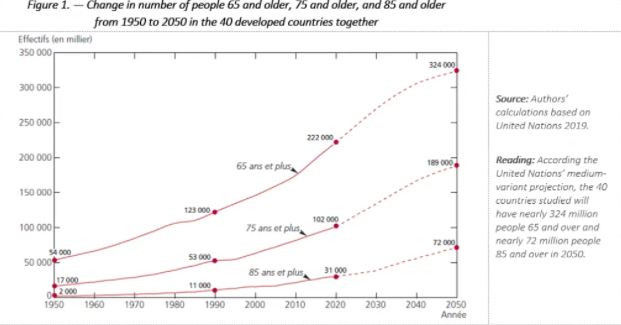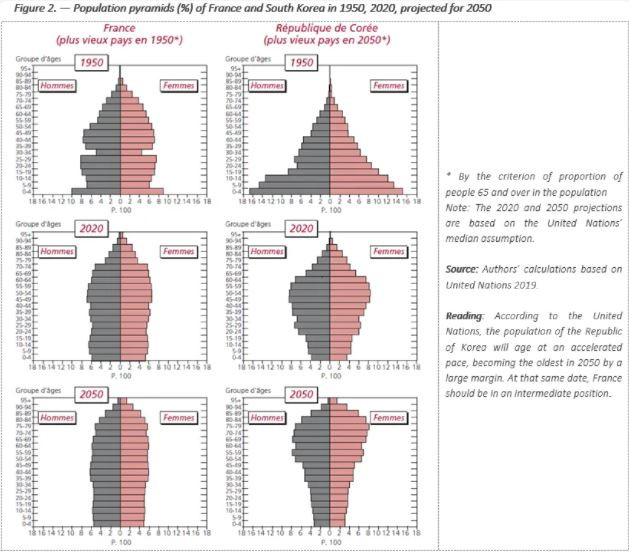Population aging is accelerating in France and most developed countries

The United Nations projects that between now and 2050 the number of older persons (65 and over) will double worldwide, from 700 million in 2020 to 1.5 billion, a proportional increase of 9% to 16%. As life expectancy continues to rise and baby boomers reach old age, France is adding 3 older persons to its population every five minutes. Developed countries’ populations are aging inexorably, creating new equilibria that societies have to adapt to. Drawing on demographic data from 40 “high longevity” countries*, INED researchers Carole Bonnet, Emmanuelle Cambois, and Roméo Fontaine shed light on current aging dynamics as related to health, changes in family and couple situations, and intergenerational transfers, and identify the challenges involved, such as funding retirement pensions and aid to dependent older persons.
France is not the fastest-aging country
Population aging in developed countries is driven by composite demographic mechanics: baby boomers with longer life expectancies reaching old age, and variable proportions of younger people. Taken together, the 40 countries studied* had nearly four times as many persons aged 65 and over in 2020 as they did in 1950: 222 million now as opposed to 54 million then (Figure 1). France experienced sustained increase in its older population over that period, which sped up considerably from 2011. According to the United Nations’ medium-variant projection, this “population graying” process should continue in the 40 countries, leading to nearly 324 million older persons (65 and over) (Figure 1). However, because France’s composite younger population is larger than that of other countries, France is not expected to figure among countries with spectacular older person numbers. 65-and-overs should account for 28% of its population in 2050, compared to around 36% of Southern European countries’ and 38% of Japan’s and South Korea’s. This last country is likely to be the “oldest” in 2050, whereas in 1950 it belonged to the set of “youngest” countries (Figure 2).
Years lived in a situation of “contained” autonomy loss
The notion of age evolves along with the aging process. In terms of “years left to live,” people in their 70s now resemble yesteryear’s 60 to 70-year-olds. For some, the years of life gained over the decades go together with functional disorders due to the fact that medical, health, and social advances have enabled many more people than before—including fragile individuals—to attain great old age, a time in life when health problems are especially common. Such disorders may make it difficult to perform certain activities. However, international studies indicate that particularly complex situations of the kind that lead to severe autonomy loss are usually contained—as life expectancy continues to rise. Preventing functional disorders and accompanying people who have them in order to limit their impact on basic activities are two means of containing dependency situations. And while preventing them is a major issue and objective today, care of already dependent older people is a public policy priority.
The fundamental role of informal aid to dependent older persons
In 2014, France allocated 1.4% of its GDP to aid to dependent older persons policies, a figure that falls within the average for OECD countries (1% to 1.5% for most). Some allocate over 2% (the Netherlands, for example) or more (Sweden is at 3%), while others are below 0.5% (Portugal and Hungary). In many countries, the “balance” that aid users have to pay is so high that more than 90% of older persons cannot assume it on their own income alone. Indeed, assistance from older persons’ families is a fundamental pillar of the social protection system: 80% of dependent older persons receive aid from their families. In France as in Germany, nearly 10% of cohabit with one of their children (the figure is 27% in Italy and 35% in Spain, compared to less than 5% in the Netherlands and Sweden). Meanwhile, 40% of older dependent persons in France live alone (63% in Sweden and 58% in the Netherlands; 37% in Italy and 32% in Spain). The rising number of older persons in many countries calls not only for rethinking the principles on which public aid policies are founded but also increasing the resources societies allocate to them. These changes should also take account of aging people’s aspirations for higher quality care for themselves and their family member or professional caretakers at home and in care facilities.
Improved economic situation for retirees but differences in living conditions
Retirees’ standard of living has improved overall in the last decades, largely due to the development of comprehensive official retirement systems. While the retiree poverty rate was high in the early 1970s, notably in France, it is now in many cases lower than for the rest of the population in the countries studied. The combination of an improvement in retirees’ economic situation, lengthened life expectancy, and high numbers of baby boomers reaching retirement age has raised the question of how to keep retirement systems financially sustainable—systems designed for a very different structural equilibrium. Most of the countries studied have reformed their retirement systems to keep them financially balanced; the main approach is to set higher retirement ages. But the implications of this are not uniform across a heterogeneous population with inequalities in life expectancy, work and working conditions, health, and resources. And moves to act on other components of the equation makes system adaptation quite a difficult exercise.
Diversification of couple and family life
Population aging dynamics have gone together with significant changes in people’s life trajectories, namely family life: the number of children households have has fallen quite fast in some countries. Longer life expectancy, particularly men’s, results in longer conjugal lives at older ages, particularly for women, who used to become widows earlier in life. In parallel, conjugal lives are less linear; separation and repartnering in old age is observed much more frequently now. These developments, which are still operative, bring with them new questions on the living conditions of older persons, th family support available to them, and intergenerational ties, questions that in large part have yet to be explored.


|
DATA USED This article draws on various demographic aging indicators and situations in 40 relatively homogeneous countries in terms of health, social, and economic development—“high-longevity” countries—and projections for them for the coming decades. The analysis uses data from the United Nations’ World Population Prospects 2019 and 2050 projections (medium-variant assumption) as well as data from the Human Mortality Database (HMD), which offer greater historical depth and more detailed information (number of deaths by age and birth year) on some sample countries. * The 40 developed countries of the sample — European Union (27 countries): Austria, Belgium, Bulgaria, Croatia, Cyprus, Czech Republic, Denmark, Estonia, Finland, France, Germany, Greece, Hungary, Ireland, Italy, Latvia, Lithuania, Luxembourg, Malta, Netherlands, Poland, Portugal, Romania, Slovenia, Spain, Sweden. — Non-EU Europe (3 countries): Iceland, Norway, Switzerland, United Kingdom. — North America (2 countries): Canada, United States. — Australasia (2 countries): Australia, New Zealand. — East and Southeast Asia (4 countries): Hong Kong (SAR China), Japan, Republic of Korea, Singapore. — West Asia (1 country): Israel. |
Source:Carole Bonnet, Emmanuelle Cambois, Roméo Fontaine, Population Ageing in High-Longevity Countries: Demographic Dynamics and Socio-economic Challenges, Population 2, 2021
On line:November 2021
